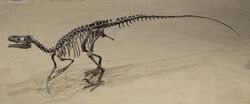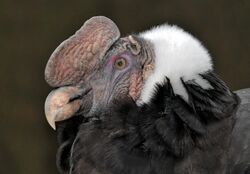Biology:Maniraptoromorpha
| Maniraptoromorphs | |
|---|---|

| |
| Skeleton mount of Ornitholestes hermanni | |

| |
| Andean condor (Vultur gryphus) | |
| Scientific classification | |
| Domain: | Eukaryota |
| Kingdom: | Animalia |
| Phylum: | Chordata |
| Clade: | Dinosauria |
| Clade: | Saurischia |
| Clade: | Theropoda |
| Clade: | Coelurosauria |
| Clade: | Tyrannoraptora |
| Clade: | Maniraptoromorpha Cau, 2018 |
| Subgroups | |
| |
Maniraptoromorpha is a clade of coelurosaurian theropod dinosaurs that includes taxa such as Ornitholestes, Compsognathidae and Maniraptoriformes.[4][1] There have been several phylogenetic analyses that have shown support in the grouping of Maniraptoriformes with at least the aforementioned Ornitholestes.[5] This group was named by Andrea Cau, who defined it as the "most inclusive clade containing Vultur gryphus Linnaeus, 1758, and excluding Tyrannosaurus rex Osborn, 1905."[4]
This group of coelurosaurs according to Cau (2018) has the following synapomorphies:[4]
Keel or carinae in the postaxial cervical centra, absence of hyposphene-hypantra in caudal vertebrae (reversal to the plesiomorphic theropodan condition), a prominent dorsomedial process on the semilunate carpal, a convex ventral margin of the pubic foot, a subrectangular distal end of tibia and a sulcus along the posterior margin of the proximal end of fibula.
In 2019 Hendrickx et al. established the maniraptoromorph subclade Neocoelurosauria as a branch-based node for the clade containing Maniraptoriformes and Compsognathidae.[1]
References
- ↑ 1.0 1.1 1.2 Hendrickx, C.; Mateus O.; Araújo R.; Choiniere J. (2019). "The distribution of dental features in non-avian theropod dinosaurs: Taxonomic potential, degree of homoplasy, and major evolutionary trends". Palaeontologia Electronica 22 (3): 1–110. https://docentes.fct.unl.pt/omateus/publications/distribution-dental-features-non-avian-theropod-dinosaurs-taxonomic-potential-d.
- ↑ Choiniere, J. N.; Clark, J. M.; Forster, C. A.; Xu, X. (2010). "A basal coelurosaur (Dinosauria: Theropoda) from the Late Jurassic (Oxfordian) of the Shishugou Formation in Wucaiwan, People's Republic of China". Journal of Vertebrate Paleontology 30 (6): 1773–1796. doi:10.1080/02724634.2010.520779.
- ↑ Zichuan Qin; James Clark; Jonah Choiniere; Xing Xu (2019). "A new alvarezsaurian theropod from the Upper Jurassic Shishugou Formation of western China". Scientific Reports 9 (1): Article number 11727. doi:10.1038/s41598-019-48148-7. PMID 31409823. Bibcode: 2019NatSR...911727Q.
- ↑ 4.0 4.1 4.2 Andrea Cau (2018). "The assembly of the avian body plan: a 160-million-year long process". Bollettino della Società Paleontologica Italiana 57 (1): 1–25. doi:10.4435/BSPI.2018.01. http://paleoitalia.org/media/u/archives/01_Cau_2018_BSPI_571.pdf.
- ↑ Hendrickx, C.; Hartman, S.A.; Mateus, O. (2015). "An Overview of Non- Avian Theropod Discoveries and Classification". PalArch's Journal of Vertebrate Palaeontology 12 (1): 1–73.
Wikidata ☰ Q52762328 entry

